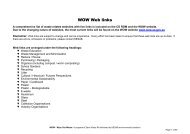WOW in Curriculum.pdf - Wipe Out Waste - WOW
WOW in Curriculum.pdf - Wipe Out Waste - WOW
WOW in Curriculum.pdf - Wipe Out Waste - WOW
Create successful ePaper yourself
Turn your PDF publications into a flip-book with our unique Google optimized e-Paper software.
<strong>Waste</strong> M<strong>in</strong>imisation<br />
Currently over 1 million tonnes of solid waste is sent to landfi ll <strong>in</strong> SA per year.<br />
That equates to almost 1 tonne / person / year <strong>in</strong> SA (or over 2kg per day).<br />
South Australia’s strategic plan aims to reduce this by 25% by 2014.<br />
To create a susta<strong>in</strong>able future, we must act now to reduce waste at school, at home and at work.<br />
The <strong>Waste</strong> Hierarchy is an accepted philosophy for<br />
prioritis<strong>in</strong>g and guid<strong>in</strong>g efforts to manage waste. <strong>Waste</strong><br />
avoidance and reduction are the optimal approach to<br />
waste management, followed by reuse, recycl<strong>in</strong>g and<br />
recovery, with treatment and disposal of waste the least<br />
preferred options.<br />
Schools and communities are generally familiar with the<br />
concept of the 3Rs (or 5Rs, <strong>in</strong>clud<strong>in</strong>g reth<strong>in</strong>k and refuse).<br />
These are outl<strong>in</strong>ed below, and expla<strong>in</strong>ed <strong>in</strong> terms of<br />
priority and effectiveness.<br />
It’s important to remember that the 3Rs of<br />
waste reduction are not equal!<br />
Reduc<strong>in</strong>g the volume of products we consume is the<br />
most important of the 3Rs because it reduces our impact<br />
on the environment the most. Reth<strong>in</strong>k<strong>in</strong>g the types of<br />
products we purchase and refus<strong>in</strong>g excess packag<strong>in</strong>g<br />
are important aspects of avoid<strong>in</strong>g and reduc<strong>in</strong>g waste.<br />
Reus<strong>in</strong>g materials comes next <strong>in</strong> the waste hierarchy.<br />
When we reuse, we save more than just the material<br />
from which a product is made. Large quantities of energy<br />
that we can’t see and don’t th<strong>in</strong>k about – ‘embedded /<br />
embodied’ energy – are also part of every product,<br />
built <strong>in</strong>to it from m<strong>in</strong><strong>in</strong>g to manufacture to disposal with<br />
transportation <strong>in</strong>volved at every stage of its life.<br />
Recycl<strong>in</strong>g lessens our environmental impact to<br />
a smaller degree than reduc<strong>in</strong>g or reus<strong>in</strong>g. While<br />
recycl<strong>in</strong>g conserves energy and raw materials, it also<br />
requires energy to collect, sort, clean, melt or pulp, and<br />
remanufacture recycled materials <strong>in</strong>to new items. With<br />
some materials, each round of recycl<strong>in</strong>g dim<strong>in</strong>ishes the<br />
quality of the recovered materials.<br />
For these reasons, it is important to reduce and reuse as<br />
much as possible and only then resort to recycl<strong>in</strong>g.<br />
<strong>WOW</strong> - <strong>Wipe</strong> <strong>Out</strong> <strong>Waste</strong>: A program of Zero <strong>Waste</strong> SA delivered by KESAB environmental solutions<br />
4<br />
Recycle is only<br />
halfway up the<br />
hierarchy . . .<br />
<strong>Waste</strong> Hierarchy<br />
<strong>Waste</strong>: Beyond Recycl<strong>in</strong>g<br />
AVOID<br />
DISPOSE<br />
Recycl<strong>in</strong>g?<br />
You are here!



